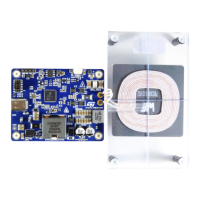7 Designing a wireless power transmitter based on STEVAL-
WBC2TX70 evaluation board
We strongly recommend limiting modifications of the schematic to a minimum, as the board schematic and BOM
were designed both for performance and cost. Caution should also be paid when modifying the layout of the
board.
We also recommend using tight tolerance components - most importantly for the sensing resistors, which will
ensure a reliable performance of the control and protection logic of the device.
The additional NTC is not supported by the current firmware but shall be available in future updates.
7.1 BOM reduction suggestions
The FAN control and power circuits are optional and may be omitted in a custom design.
The current design supports several input power connectors for increased flexibility. A custom design may reduce
them to a single one, reducing both cost and space required.
The STSAFE is only necessary if the final product shall be compatible with devices supporting Qi 1.3 or later. It
can be omitted for custom applications which do not require Qi certification.
7.2 Layout guidelines
7.2.1 High power tracks
Tracks carrying high currents should be wide enough to allow the generated heat to be dissipated easily. We
recommend using several vias when transitioning to a different layer. The ground tracks design should follow the
same guidelines to accommodate the return currents.
Figure 48. Layer 1 high power tracks
UM3286
Designing a wireless power transmitter based on STEVAL-WBC2TX70 evaluation board
UM3286 - Rev 1
page 64/84

